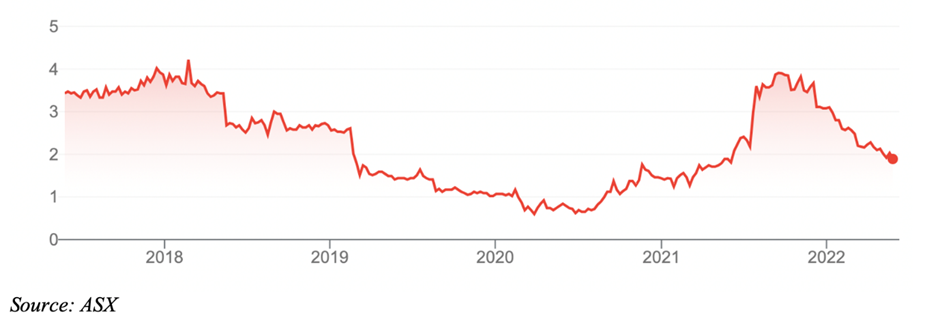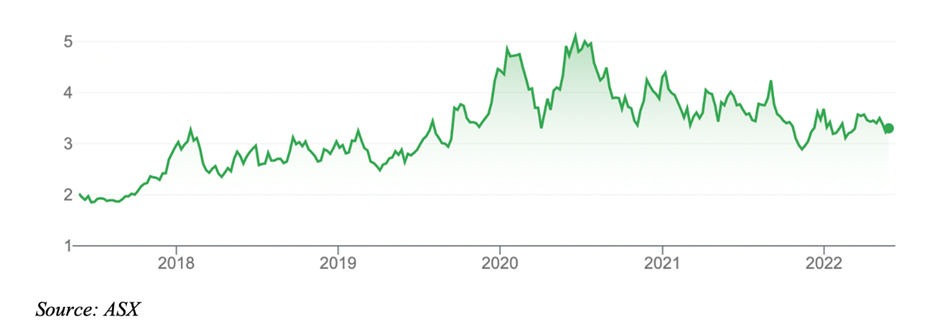Security Alert: Scam Text Messages
We’re aware that some nabtrade clients have received text messages claiming to be from [nabtrade securities], asking them to click a link to remove restrictions on their nabtrade account. Please be aware this is likely a scam. Do not click on any links in these messages. nabtrade will never ask you to click on a link via a text message to verify or unlock your account.
Take a look at these two small-cap industrials
Both major political parties in the Federal election downplayed the effects of COVID-19. The pandemic was a lesser issue compared to climate change, a new integrity commission or gender equity.
No doubt that reflected community attitudes. It feels like COVID-19 is behind us, even though the pandemic is far from over. Sadly, just ask China or North Korea. New COVID-19 variants remain an ongoing risk, as does the prospect of a nasty cold and flu season, after a couple of years of respite.
For some companies, the pandemic’s effects will last for years. Some markets became so clogged during COVID-19 that they will take years to unwind. That will create a backlog of orders as companies meet pent-up demand for their products or services.
Start with heavy vehicles. Order waiting times blew out during the pandemic because of supply-chain blockages. Trucking companies are likely to have older fleets than usual in the next few years, which means more wear and tear. That’s good for parts suppliers.
Courts of law were also blocked. A backlog of cases over the next few years will be good for listed law firms and particularly litigation funders that fund class actions.
Then there are home furnishings. Those who tried to buy a couch during COVID-19 had to wait longer for orders to be fulfilled. Some furniture companies have big forward-order books with locked-in sales over the next few years. Nick Scali is an example.
I could go on with other industries that will take years to get back to normal after COVID-19. The cinema industry is an obvious example. How many movies have you seen at cinemas in the past year compared to previous years?
So, too, is tertiary education as international students return in force over the next few years. That’s good for companies like IDP Education which place international students in Australia and provides English-language testing services. It’s also good for health insurers like NIB Holdings which sells private health insurance to international students, some of whom are ineligible for Medicare.
Clearly, some companies will have earnings tailwinds over the next few years as supply-chain blockages that formed during COVID-19 unwind. I suspect the market is underestimating the significance of this earnings uplift for affected companies.
COVID-19 had such a profound effect that one can find examples across all industries. In this article, I’ve focused on small-cap industrials, a part of the market that has underperformed in recent years.
In volatile, uncertain markets, investors seek safety in defensive large-cap stocks with big balance sheets and more reliable earnings and dividends. They dump riskier small-caps or speculative plays.
That creates opportunity. Some investors forget that small-cap industrials often have higher relative exposure to the Australian economy (compared to large caps that have a higher proportion of offshore earnings) and are well-placed to navigate volatile markets. They also forget that some small-caps are nimble and well-run.
Here are two small-cap industrials that look interesting at current prices, as underlying demand for their products or services strengthens after COVID-19:
1. MaxiPARTS (MXI)
I remember writing about MaxiPARTS’ forerunner company – MaxiTRANS. It was one of Australia’s largest semi-trailer manufacturers and suppliers of trailer parts. MaxiTRANS was renamed MaxiPARTS when it sold its volatile trailer business in July 2021.
The new MaxiPARTS became a dedicated commercial parts-distribution business. It provides axles, suspensions, brakes, filters, lubricants and other truck parts. Offloading the trailer business made strategic sense.
A big change came in February 2022 when MaxiPARTS acquired Truckzone Group for $18 million. The deal made MaxiPARTS one of Australia’s largest independent multi-site parts distributors. The acquisition was an excellent fit for MaxiPARTS.
But the market is unconvinced. MaxiPARTS’ shares have fallen this year, although care is needed with share-price movements due to special dividends, other acquisition payments and equity capital raisings.
I like the medium-term outlook for heavy-vehicle parts demand. With new trucks taking longer to order, more trucking companies will work their existing vehicles harder. Fleets will age. New parts will be needed to extend vehicle life. That’s good for parts supplies like MaxiPARTS.
At its half-year FY22 result, released in February 2022, MaxiPARTS maintained earnings guidance in line with broker forecasts. The company said stock availability in its aftermarket range continues to improve. MaxiPARTS has been able to invest in its inventory, setting it up for stronger sales in the second half.
As with many companies, labour shortages have been an issue for MaxiPARTS during COVID-19 but it closed no sites in the first half and expects staffing conditions to improve as COVID-19 infection rates fall over the next few months.
MaxiPARTS expects the main cost and revenue-synergy benefits from the Truckzone acquisition to flow in FY23.
As a $90-million microcap (at $1.92), MaxiPARTS suits experienced investors who understand the features, benefits and risks of this style of investing. After a tough few years, MaxiPARTS could rev a little harder in FY23, amid stronger parts demand and supply.
MaxiPARTS (MXI) stock price chart

2. Omni Bridgeway (OBL)
Omni Bridgeway, a global litigation funder, is better known to Australian small-cap investors as IMF Bentham. In February 2020, IMF changed its name to Omni Bridgeway after the two businesses merged in November 2019.
Omni Bridgeway had built a strong business in Europe and Asia over more than three decades. IMF was Australia’s leading listed litigation funder, which financed prominent consumer and shareholder class actions and took a cut of the proceeds. The merger had a strategic rationale for expanding IMF’s global footprint.
Litigation funding has been a strong growth market here and overseas. It involves a third party funding the costs of litigation in return for a proportion of the proceeds if the action is successful. For example, thousands of shareholders forming class actions – which a litigation funder finances – against a listed company alleged to have breached disclosure rules.
I’ve written about litigation funding many times over the past decade, in my work on corporate governance. It was a booming market that needed to be better regulated because some opportunistic firms were entering this market and pursuing low-merit cases.
Litigation funding is better regulated these days through the requirement for funders to have an Australian Financial Services (AFS) licence in most instances. In some ways, litigation funders are like fund managers: they have a portfolio of cases that they fund over several years. Their success relies on picking the right cases to back. Some small-cap fund managers I know who follow Omni Bridgeway believe its caseload could be worth about $800 million of cash flow in the next few years, as a backlog of cases is heard after COVID-19. The company has net cash and receivables of about $200 million and a market capitalisation of $844 million at a $3.29 share price.
Omni Bridgeway has a negative 17.3% total return (including dividends) over one year in a falling Australian share market. Omni’s income can be lumpy due to the nature of litigation funding, but it’s hard to see why the stock has fallen from a 52-week high of $4.38 to $3.29. General market weakness explains much of the fall.
I like the short-term outlook for litigation funders as a backlog of cases is heard, and the medium-term outlook as more class actions are formed.
Omni Bridgeway has a genuine global footprint and higher regulatory standards arguably strengthen its position by raising the barrier to entry for small players. It’s one of the better-run small-cap industrials on the ASX.
From a technical analysis perspective, Omni Bridgeway needs to hold above $3, a point of previous share-price support on its chart.
Omni Bridgeway (OBL) stock price chart

Tony Featherstone is a former managing editor of BRW, Shares and Personal Investor magazines. All prices and analysis at 26 May 2022. This information was produced by Switzer Financial Group Pty Ltd (ABN 24 112 294 649), which is an Australian Financial Services Licensee (Licence No. 286 531This material is intended to provide general advice only. It has been prepared without having regard to or taking into account any particular investor’s objectives, financial situation and/or needs. All investors should therefore consider the appropriateness of the advice, in light of their own objectives, financial situation and/or needs, before acting on the advice. This article does not reflect the views of WealthHub Securities Limited.
